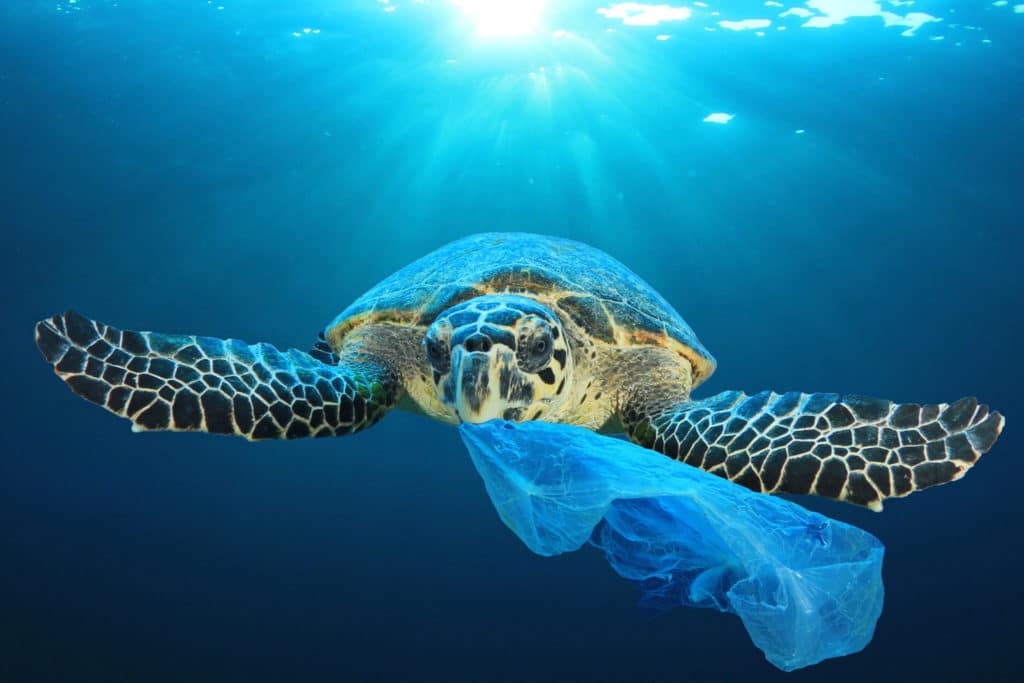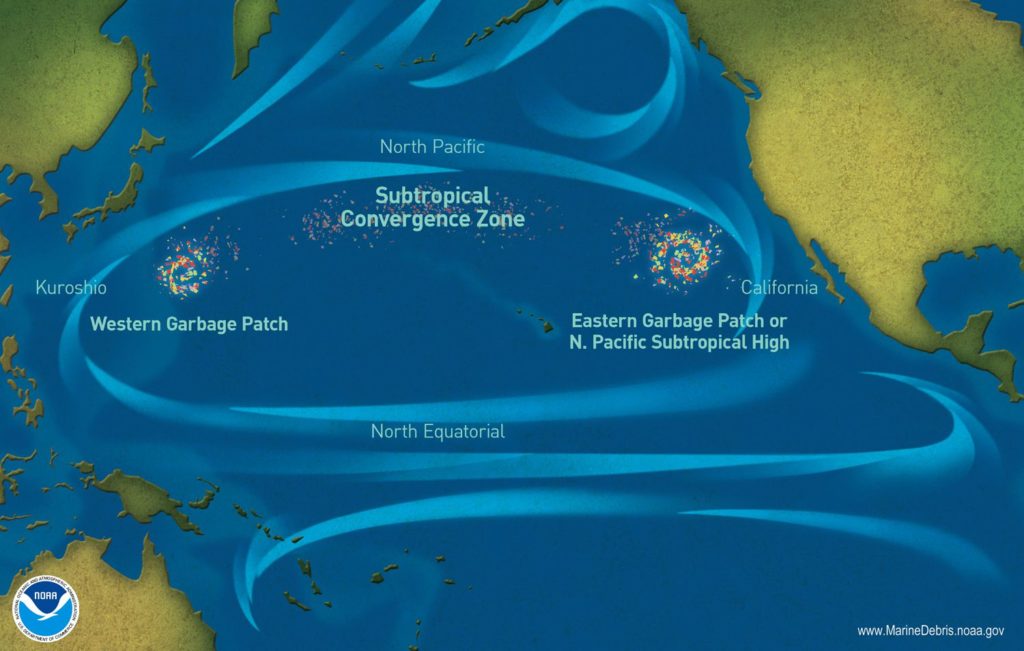In less than 30 years, scientists predict plastic will outnumber all of the fish in the ocean. That’s plastic from food wrappers, straws, bottles, grocery bags, and even toothbrushes. One study found approximately 8 million metric tons of plastic entered the ocean in 2010. Since then, the amount of plastic in our waterways continues to increase.

The National Oceanic and Atmospheric Administration (NOAA) calculates 8 million metric tons is equal in weight to nearly 90 aircraft carriers. That’s a lot of plastic.
Since then, the amount of plastic in our waterways continues to increase and, unfortunately, it doesn’t decompose. A large portion, however, breaks down into tiny pieces when it’s tossed around in the ocean and becomes micro-plastics, which are smaller than your fingernail.
“It also ends up, not just in our oceans, but in our waterways,” says Kaitlin Gannon, education coordinator, at the Jacques Cousteau National Estuarine Research Reserve, administered through Rutgers University.
Gannon shares steps on what each of us can do to address and improve this situation.
1. Every minute enough plastic to fill one garbage truck makes its way into our oceans
“The problem is plastics aren’t disposed of properly,” Gannon explains. “You’ve seen overflowing trashcans outside a supermarket or on the street. Some of the trash winds up on the ground or it’s picked up by the breeze and blown away. There’s a good chance that plastic finds its way into a storm drain, a waterway, and eventually the ocean.”
Gannon has an easy fix. She suggests not tossing your trash into garbage cans teeming with rubbish. “Instead, take it home and place it in your recycling bin,” she says.
2. The Great Pacific Garbage Patch is a misnomer

As the image above depicts, the Great Pacific Garbage Patch is a series of trash islands polluting various sections of the Pacific Ocean.
The name sounds like it’s one incredibly large area. In actuality, plastic is in many areas throughout the ocean. According to NOAA, the “exact size, content, and location of the garbage patches are difficult to accurately predict” because of constantly changing ocean currents and winds.
Gannon suggests volunteering to pick up litter in your local community. “Many towns hold community river and beach cleanups,” she says. “It’s easy to participate and you’ll be doing a great service by keeping plastic out of our waterways.”
The trash we throw away ends up in the ocean, it’s that simple. Drawing awareness to the tragedy of the Great Pacific Garbage Patch, and other ocean dead zones, will, hopefully, make some of us think twice about consuming single use plastics. In addition, we can all be on the lookout for products that repurpose plastic into something useful.
3. The average U.S. citizen consumes approximately 167 plastic water bottles each year—but recycles just 25% of them
“We don’t have to buy bottled water,” Gannon says. “And we don’t have to use plastic straws and plastic grocery bags. Plastic straws wind up in our rivers, lakes, estuaries, and oceans. It’s a major problem. The same goes for plastic grocery bags. These items aren’t biodegradable.”
Gannon uses a metal straw that she keeps in her bag. She also keeps cloth shopping bags in her car. “And you can buy a reusable water bottle,” she says. “The plastic from these items take a long time to degrade and some don’t ever degrade. It can take 20, 50, 100 years or more for these plastics to decompose.”
4. Eight out of ten tourists travel to coastal areas on vacation and are met by polluted waterways
“Marine debris has an economic impact on tourism,” Gannon says. “Coastal towns rely on ecotourism in and around the oceans.”
A report from the World Wildlife Fund found litter from plastics increase by 40 percent in the Mediterranean at the height of tourist season. Tourists who visit beaches are greeted by discarded flip flops, plastic bags, candy wrappers, straws, grocery bags, and other trash made from plastic.
The Global Tourism Plastic Initiative is trying to curtail pollution through collaborative efforts from tourism, businesses, and government agencies. They’re setting concrete and actionable commitments by 2025 to find alternatives to the plastic problem.
5. A study from The Royal Society found many of the fish we eat have ingested microplastics.
Scientists found that fish and other marine organisms can’t tell the difference between microplastics and food. Unfortunately, these sea creatures cannot digest plastic. It fills their stomachs, prevents them from eating real food, and causes them to starve.
Seabirds also ingest a lot of plastic and get caught in plastic rings, the kind that hold a six-pack of soda or beer together. Scientists at Project Ocean Blue, an environmental nonprofit, believe approximately one million birds die every year from ingesting plastic.
“We see a lot of harm to marine life, seabirds, and other wildlife through ingestion and entanglement of fishing gear,” Gannon says. “Clams, oysters, and other bivalves feed on plankton and other particles. Unfortunately, some of those ‘other” particles are microplastics.”
Avoid purchasing any products that use plastic rings. Sea creatures such as sea lions, otters, sea turtles, penguins, seals, and other wildlife get trapped in them, too.
6. No more microbeads thanks to the Microbead-Free Waters Act
Microbeads are tiny plastic beads found in exfoliating and cleansing products. They were in toothpaste, acne scrubs, soap, nonprescription drugs, laundry detergents, and shampoo. “President Obama signed the Microbead-Free Waters Act in 2015,” Gannon says. “After washing your face, your teeth, or did your laundry with these products, these plastic microbeads would travel into our waterways.”
The law gave manufacturers time to stop using microbeads in their products. By now, newly manufactured products should not contain microbeads. Not all products found on supermarket and drug store shelves are new. It’s still possible to find products that contain microbeads.
“Read the ingredients,” Gannon says, “and don’t purchase products with microbeads in them. And look for words that start with “poly” in the ingredients list. Poly is a polymerized plastic.”
If you want an exfoliating skin product, Gannon suggests looking for one that’s made with crushed up walnut or coconut shells.
7. Plastic damages coral reefs
Scientists believe plastic blocks sunlight and oxygen, which coral reefs need in order to thrive. Without sunlight and oxygen, coral reefs lose their outer layers. It’s a problem because coral reefs provide a home to more than 25 percent of marine life. In return, fish excrete ammonium through their gills, which coral needs in order to grow.
Without oxygen, dead zones form. Plants, fish, and other sea creatures can’t live in areas with little or no oxygen.
To reverse the effects of dead zones:
- Recycle according to your town’s rules.
- Don’t use single use plastics.
- Spread the word to family, friends, coworkers, and government politicians.
8. People living near plastic production sites have a higher likelihood of health problems
Many plastic manufacturing plants are in low-income areas and expose residents to toxins. “It’s important for communities to organize and talk to local political leaders about safety measures,” Gannon says.
Making a change
“In some instances we have to switch our habits,” Gannon says. “We need to do things differently, and the small things like using metal straws, recycling, and finding out what recycling products your town accepts and doesn’t is important. We can change our purchasing habits to take better care of our waterways and of our health.”